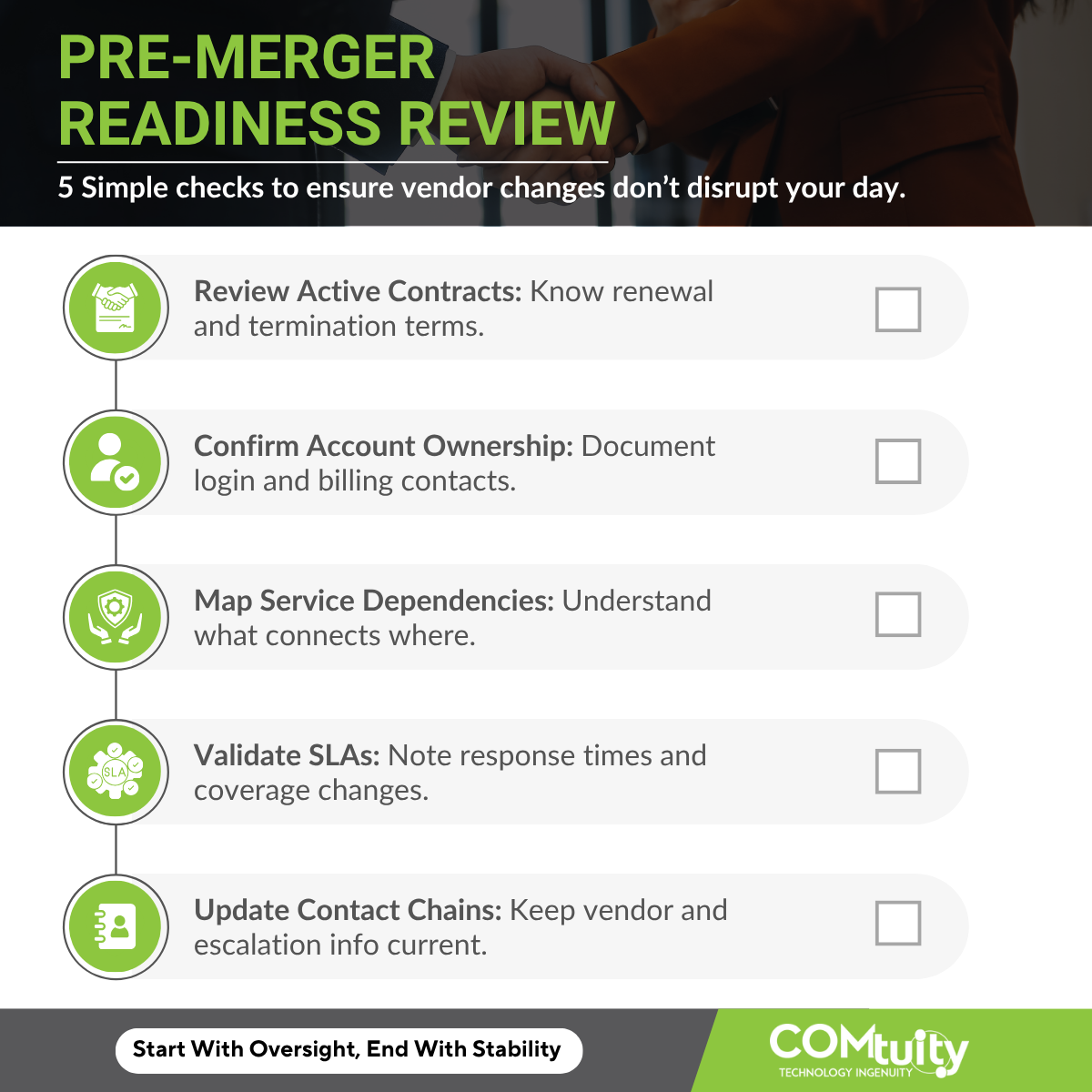When a carrier or supplier merges, the first thing to falter isn’t service; it’s communication.
A support ticket takes longer than usual. A new billing portal appears without instructions. Your internal team spends hours just figuring out who to call. What starts as a minor delay can quickly turn into missed deadlines or downtime across locations.
Without vendor management, the steady rhythm of your IT operations can quickly become interrupted. You can’t predict mergers, but you can strengthen your IT foundation. Doing so means your operations stay steady no matter what changes come your way. That stability protects uptime across every location, prevents unplanned costs, and keeps teams productive through change.
With the right groundwork, carrier transitions stop being chaotic events and instead become manageable adjustments. And the good news is, you don’t have to do it alone. A well-structured approach to vendor and contract management helps you stay informed, responsive, and calm even when the supplier landscape shifts. See how COMtuity helps manage M&A with ease.
How M&A Disrupts Vendor Communication
Mergers often trigger restructuring inside the supplier organization. Departments merge, roles shift, and long-time contacts are reassigned. The people you’ve worked with directly may not have the same access or authority they once did.
You might submit a ticket only to find it routed to a new department that doesn’t recognize your account history. This kind of confusion can delay fixes, increase frustration, and erode confidence.
Inside your business, the uncertainty spreads just as quickly. One team might believe a contract has been renewed while another assumes it has expired. Inconsistent information slows decision-making and creates internal stress at a time when clarity is most needed.
This is where a disciplined approach to IT vendor management becomes invaluable. Having a single, organized record of all vendor relationships, service details, and escalation contacts helps you maintain control even when suppliers are restructuring.
You can easily see who to contact, which contracts are active, and where potential risks lie. Documentation, communication, and oversight from a trusted partner turn uncertainty into something manageable.
Vendor Management Habits That Keep Teams Steady
Businesses that remain stable during supplier mergers usually share a few habits in common. They maintain visibility, encourage communication, and build a vendor management system that makes transitions predictable.
Establish a Vendor and Contract Management System
You don’t need specialized tools. The foundation of solid vendor management is strong documentation. At a minimum, you should be keeping a centralized list that includes:
- Vendor names and services provided
- Renewal and expiration dates
- Primary and escalation contacts
- Contract terms and pricing details
- Service-level expectations
Updating this information regularly ensures your team can act quickly when supplier changes occur. It also simplifies audits, renewals, and performance reviews.
Weigh Fallback Options
If a merger causes disruption, redundancy helps protect uptime. Maintain awareness of alternative carriers or service providers that could step in if needed.
Multi-location businesses in particular benefit from having backup options for internet, voice, or data center services. The goal isn’t to replace your main provider immediately but to make sure you have alternatives if problems persist.
Prioritize Training and Internal Awareness
Your staff should know exactly who to contact for each vendor issue and where to log tickets. Run short internal refreshers every few months to review escalation steps. Even a half-hour session can prevent major delays later. Consistency builds confidence, and confidence prevents overreaction during change.
Use Third-Party Expertise Wisely
Working with a strategic IT advisor can add stability to your operations without increasing internal workload. At COMtuity, we maintain active relationships with suppliers, which means we can escalate issues faster and get clear answers when direct communication stalls.
A good advisor doesn’t replace your internal IT staff; they extend its reach. They focus on carrier management and vendor oversight while your team focuses on daily operations. This partnership model helps you stay proactive even during industry shifts.


Turn Change into Confidence with IT Vendor Management
Supplier and carrier mergers will continue as the industry consolidates. While you can’t control when they happen, you can control how prepared your organization is to handle them.
A clear playbook turns uncertainty into routine. It includes updated vendor documentation, regular communication practices, defined internal roles for escalation, and verified external contacts. It’s a framework your team can follow even when information is incomplete.
The structure you build today determines how stable your operations will be tomorrow. With COMtuity as your tech advisory partner, you gain steady oversight across all your vendor relationships. We help you maintain clear documentation, establish strong communication channels, and stay aligned even when your suppliers shift.
Mergers may disrupt supplier operations, but they don’t have to disrupt yours. With COMtuity’s support, you can keep your environment steady, informed, and ready for whatever changes come next.
Ready to strengthen your vendor management strategy? Schedule a call with COMtuity today to start building your playbook for lasting stability.

Common FAQs
What is IT vendor management, and why does it matter during carrier mergers?
IT vendor management is the process of tracking, evaluating, and maintaining technology supplier relationships. During carrier mergers, it helps ensure that contracts, support processes, and billing remain consistent even as the supplier’s internal structure changes.
How can I tell if a merger will affect my operations
Watch for small signs like slower ticket responses, changes in account contacts, or new billing portals. These usually appear before larger service shifts.
What should I document before a merger happens?
Keep updated records of all vendor contracts, contacts, escalation paths, renewal dates, and costs. Having this data ready prevents confusion when supplier changes occur.
How often should I review vendor performance?
Every three to six months is a good rhythm. Regular reviews keep your vendor relationships healthy and help identify small issues before they grow.
How can a tech advisor help during supplier or carrier mergers?
A tech advisor maintains direct relationships with carriers and suppliers, giving your business access to faster updates and escalations. They provide structure, coordination, and visibility, helping your team stay stable and informed throughout transitions.



